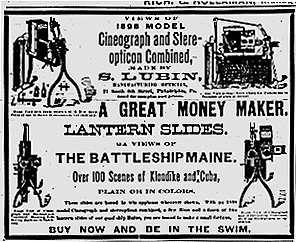
 |
| 1898 Lubin Model
|
In the 1890s, vaudeville, print media, and film were inextricably bound together in an intertextual and what we might call (following film scholars' discussions of early cinema's intermediality) an "intermedial" relationship. Vaudeville and the theatrical medium's method of variety programming provided early film producers with an existing format through which they could exhibit their films (Allen Vaudeville and Film). Furthermore, as Leo Charney and Vanessa Schwartz point out, "Cinema [in the 1890s] constituted only one element in
an array of new modes of technology, representation, spectacle,
distraction, consumerism, ephemerality, mobility, and entertainment--and
at many points was neither the most compelling nor the most promising one"
(1).
 |
Battlefield Telephone
|
One aspect of this intermediality is exemplified by advertisements in the New
York Clipper for Sigmund Lubin's "1898 model" which combined a
cineograph and stereopticon, thus embodying both the emerging technology
of the film projector while also retaining the residual technology from an older history of screen practice.
Indeed, several communication technologies were exploited by the
military, the news media, and the entertainment industry to mediate the
war with Spain. For instance, the Milwaukee Journal
published an illustrated column about the use of battlefield telephones in
Cuba, while a "commision stockbroker" in Worcester, Massachusetts sold "news and gossip" about the war, inviting "citiziens. . .to call and inspect [it]". As one advertisement announced: "I received yesterday, April 26 over my private wires 116 messages containing gossip and information on the [Spanish-Cuban] situation . . . ".
The Worcester Telegram was quick to advertise its own use
of the latest technologies to bring its readers the facts: "While. . .one
story was being hustled into shipshape," reports the Telegram, "a special
diamond-tipped wire was clicking off the latest news from Havana and the
editorial department was pressed into service taking [reports] from the
telephone" (February 19, 1898). Symptomatic of many newspapers'
self-fashioned participatory role, the Telegram would also brag
that its reporters were assisting divers in the Maine investigation,
which, in turn, made celebrities out of many Spanish-American War
journalists such as Stephen Crane, Frances Scovel, Richard Harding Davis,
Frederic Remington, and even a young Winston Churchill. Indeed, upon his return from
"correspondent's war," Davis would insist in Harper's Weekly that
"[Stephen] Crane [was] quite as much of a soldier as [any] man . . ."
because under enemy fire he remained "as unconcerned as though he were
gazing at a cinematograph" (160).
|


![]()